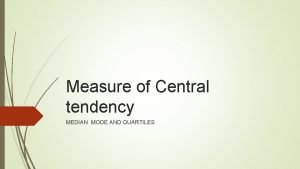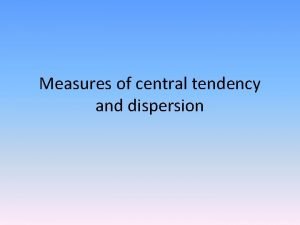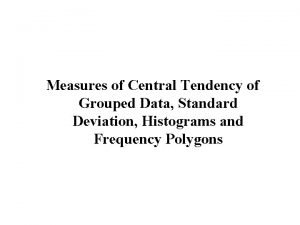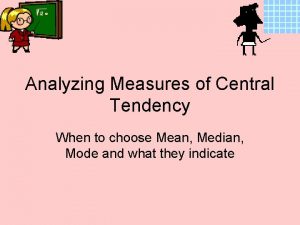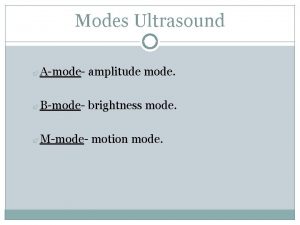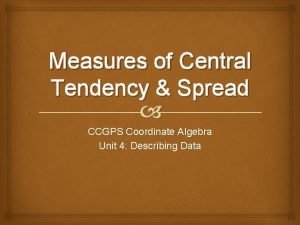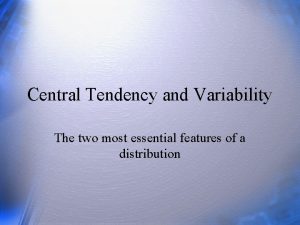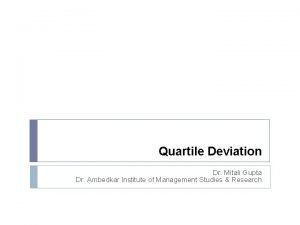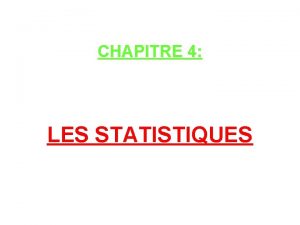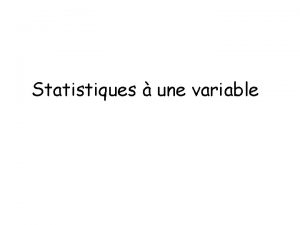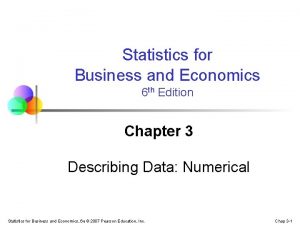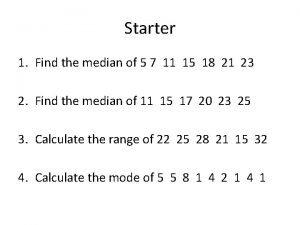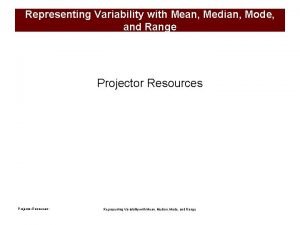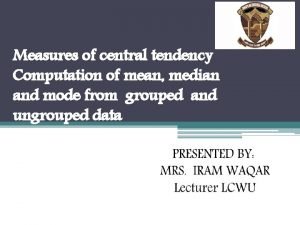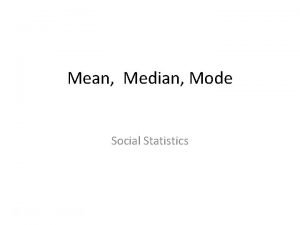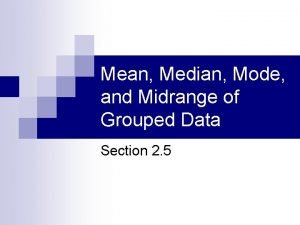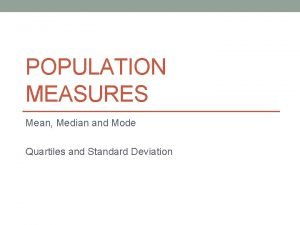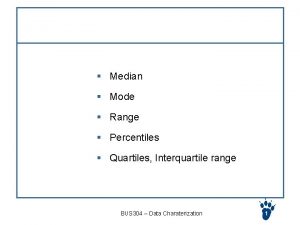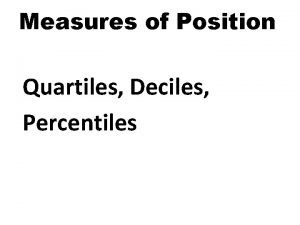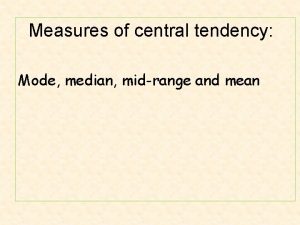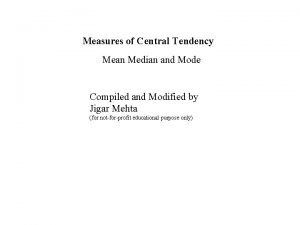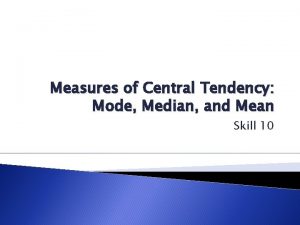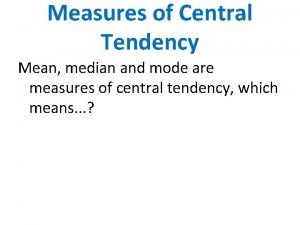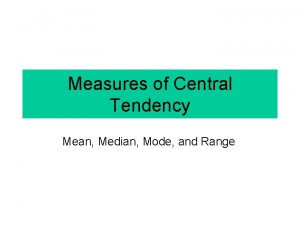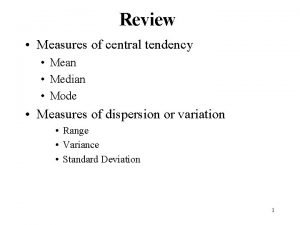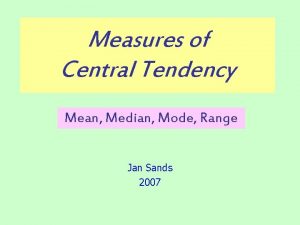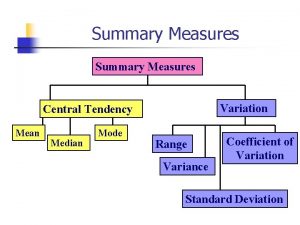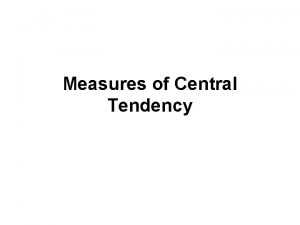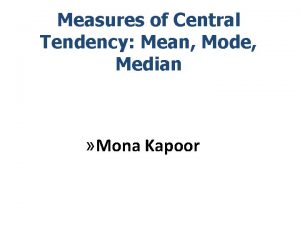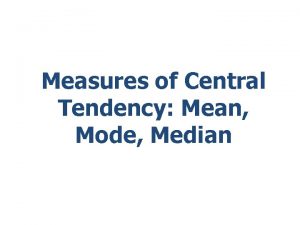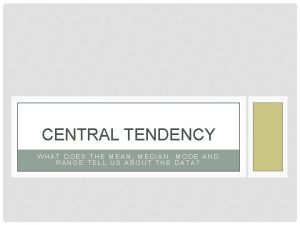Measure of Central tendency MEDIAN MODE AND QUARTILES

























- Slides: 25

Measure of Central tendency MEDIAN MODE AND QUARTILES

Measures of central tendency Measure of central tendency provides a very convenient way of describing a set of scores with a single number that describes the “PERFORMANCE” of the group. It is also defined as a single value that is used to describe the “CENTER” of the data There are three commonly used measure of central tendency. There are the following § MEAN § MEDIAN § MODE

mean Mean is the value that is obtained by “sum” of all observations divide by a number of observation

MEDIAN The median represents the observation that divides the sample into halves regardless of the weight of the observation Median is the central value of the variable that divide the series into two equal parts in such a way that half of the observation below the value and half of the observation above the value Median is defined as the value of the middle item when the data are arranged in an ascending or descending order of magnitude.

Note: In the 1 st data set there are two observation to the left of median “ 5” and two observation to the right of median. Therefore 5 is the median for both data set. By using “EXTREME” values median remain same but the mean changed.

note Median of the data set dependent on whether the number of elements in the data set is odd or even q first reorder the data set from largest to the smallest or smallest to the largest q Mark off high and low values until you reach the middle value q if there are 2 middles than add them and divided by 2

MEDIAN

COMPUTATION of median for UNGROUP DATA

COMPUTATION of median for GROUP DATA



The Mode is the most frequent score in our data set Scores or qualitative category that occurs with the greatest frequency Mode is define as the score with the highest frequency. The most frequent score. It is called nominal statistics. In a grouped data set it is mid point of class interval with the highest frequency

Computation of Mode for ungroup Data

Computation of Mode for group Data

Computation of Mode for group Data

Computation of Mode for group Data

Measures of Position - Quartiles The three quartiles Q 1, Q 2, and Q 3 approximately divide an ordered data set into four equal parts. About ¼ of the data falls on or below the first quartile Q 1. About ½ of the data falls below the second quartile Q 2. , and about ¾ of the data falls below the third quartile Q 3. The second quartile has the same median of the data set

Computation of quartile for ungroup data set 5, 6, 4, 6, 3, 7, 5, 3, 4, 5, 6, 5, 3, 2, 4, 4, 4 Find Q 1: Find Q 3: First, order the data: 2, 3, 3, 3, 4, 4, 4, 5, 5, 6, 6, 6, 7 Find Q 1: have to average 3 and 4, giving 3. 25 Find Q 3: have to average 5 and 6, giving 5

Computation of quartile for ungroup data set

Computation of quartile for group data set

Computation of quartile for group data set

Computation of quartile for group data set

ASSIGNMENT


Thank you Madeeha Rahim Visiting Lecturer Statistics
 Are quartiles measures of central tendency
Are quartiles measures of central tendency Central tendency and dispersion
Central tendency and dispersion Lower class boundary of modal class
Lower class boundary of modal class Measure of central tendency grouped data calculator
Measure of central tendency grouped data calculator How to find the mean median and mode
How to find the mean median and mode Measure of central tendency grouped data
Measure of central tendency grouped data Central tendency worksheet
Central tendency worksheet What is a-mode ultrasound used for
What is a-mode ultrasound used for Braves
Braves Central tendency and spread homework
Central tendency and spread homework Central tendency and variability
Central tendency and variability Central tendency symbols
Central tendency symbols Measures of central tendency and variation
Measures of central tendency and variation Sd formula for continuous series
Sd formula for continuous series The third quartile
The third quartile Iq quartiles
Iq quartiles Au lycée chapitre 4 vocabulaire 1
Au lycée chapitre 4 vocabulaire 1 How to solve upper quartile
How to solve upper quartile Quartile en statistique
Quartile en statistique Quartile formula
Quartile formula How to find the upper quartile
How to find the upper quartile Define mean average
Define mean average Mean median mode card game
Mean median mode card game Median solution example
Median solution example Mean median mode statistics
Mean median mode statistics Mean median mode and midrange
Mean median mode and midrange
